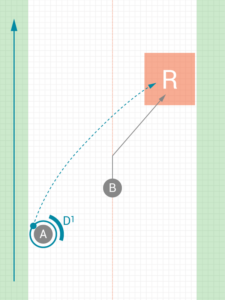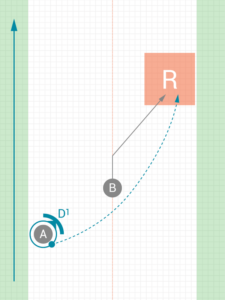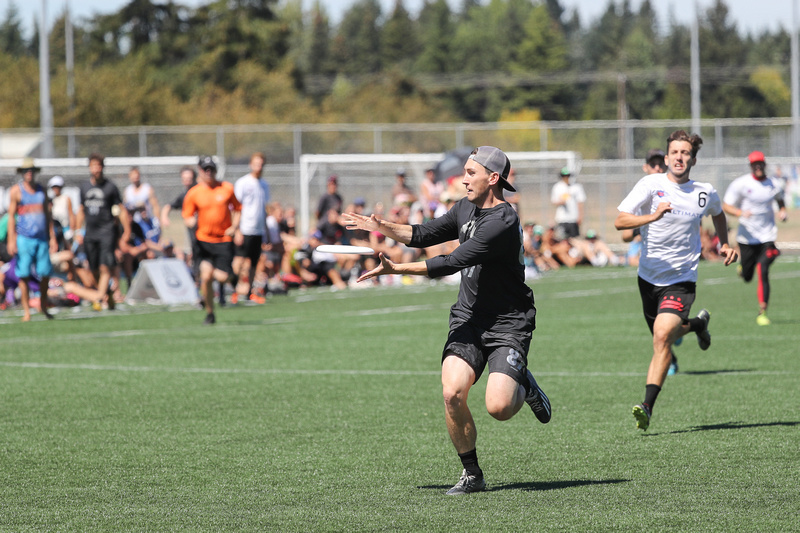[caption id=“attachment_47376” align=“aligncenter” width=“800”]
Revolver catches a huck at the Pro Flight Finale. Photo: Rodney Chen – UltiPhotos.com[/caption]This article is presented by Spin Ultimate; all opinions are those of the author. Please support the brands that make Ultiworld possible and shop at Spin Ultimate!
Long considered a dangerous – or even downright misguided – huck decision, crossfield deep throwing is becoming more and more prevalent in high level ultimate. With the disc arriving at the receiver at a difficult angle, hucking over a vertical stack with a big bend on the throw was traditionally more often the result of an execution error than an intentional strategic choice. But as throwing skill and accuracy improves and teams look for new ways to attack the deep space, these hucks are now in vogue.
Here we discuss two variants of the crossfield huck: the front side throw and the back side throw.
Front Side

This throw looks like any ordinary trap force deep shot, except that instead of being thrown flat out in front of a receiver streaking toward the endzone on the force side, it crosses from one side of the field to the other as a cutter peels off toward the breakside.
Take this first example below. It looks a little like a wayward throw at first, one that’s bumped by the wind and blown a little off course, and that the offense is fortunate to reel in.
Think again.
Despite being floaty (look at the speed of the receiver), it’s virtually impossible for the defender to make a play on this disc. Being put out to space on the break side also ensures a huge margin for error; even if this throw had gone an extra 10-15 yards, it wouldn’t have been too difficult for the receiver to reel in.
Here’s another example, almost a carbon copy of the first, but with even better execution. The defender has no chance.
It’s probably no coincidence that both throws are into the wind, which helps the disc to sit a little longer.
Of course, anything you can do, Mickle can do better, ripping this one at least 60 yards and hitting the receiver in stride.
Notice how Mickle pivots directly forwards here, making it easier to direct the disc across the field, rather than stepping out sideways and trying to do everything with his arm and wrist.
Back Side

Imagine the scenario. You’re picking the disc up on the sideline following a turnover on the break side, and you’re running a vertical stack. The mark is therefore straight up, and any cuts in your half of the field are going to require breaking the mark. Many teams will start this possession by looking to swing the disc to the middle of the field and work it up from there. However, there’s a sweet spot on the far side of the field, beyond the stack, which is an open side throw, and where downfield defenders aren’t aggressively covering. Here, a crossfield huck can be devastating to a defense.
Japan’s Buzz Bullets are famous for incorporating this throw as a staple of their offensive strategy. Here is is Masahiro Matsuno in action for Buzz against Ironside at WUCC 2014. Catch, immediately look diagonally across the field, and hit the weak side with his trademark lefty flick.
Matsuno lefty cross-field flick
Kurono does the same here, except he’s right-handed so the action is in the other direction across the field.
Compare the two; one is very bladey (shorter throw), one flatter. The exact shape of the back side throw is dependent upon the available field space, speed and angle of cut, and the defensive positioning. But the similarities are key – that deep, break side space is no longer seen as simply an occasional option, it is definitely an intentional target.
This past college season, Whitman rode Alex Hardesty’s big D-line hucks to this space ((Along with contributions from many other stellar role players.)) all the way to the National finals. She would frequently abuse her marks by stepping through and bending her hucks across the field where her receivers’ defenders had no chance.
Brute Squad also have found a lot of success looking to this space. While this example required a nice grab from the receiver, it is clear that when Amber Sinicrope saw Caitlin O’Connell with even just a couple steps of separation on the break side, the crossfield huck was a throw she was ready and looking to deliver.
This throw can be an especially great way to attack deep in the wind. The blustery conditions are obvious in this clip from Truck v Bravo, where Kolick throws the back side crossfield shot across the field. It’s not a pretty throw by any means, but there’s so much space that it really doesn’t matter. Easy catch and undefendable, even by someone as smart and athletic as Mickle, who was protecting the force side and was completely caught off guard by the huck back the other way.
Kolick cross-field lefty backhand
Bravo get in on the action too. Notice how bladey this throw is, angled so that the wind doesn’t hit the underside of the disc, making it a nice easier catch for Mickle.
How about this one from Madison Club? While the commentator thought the throw was not for the intended receiver, I disagree. There’s no defense anywhere nearby; they are all cheating over to prevent the “easy” straight throw directly downfield. As such, Camp identifies and hits the open guy, leading to an easy goal on the other side of the field.
This throw even works against a zone, as demonstrated here by Magon Liu of Fury at the Pro Flight Finale, feinting to draws the deep defender to the force side before turning and firing back across the field.
Coaching Points
It is clear that the best in the game no longer see the crossfield huck as a taboo; it has become a viable approach to attack the deep space in an area that the defense has left open. But how do they recognize when it is a good decision vs. an ill-advised turnover that will leave a coach groaning?The Men’s final at US Open saw a perfect demonstration of this skill by Goose Helton. Notice how his hips are aligned so he’s facing his target, diagonally across the field (i.e. pivoting diagonally backwards to the field). Notice the curve on the disc, holding it’s edge all the way. Notice how the receiver is initially cutting deep straight down the middle of the field, giving possible huck options to the thrower on both the force and break side, pushing his defender closer to the near side and therefore creating a much bigger space for Goose to shoot into. These are the details that make the cross-field huck a realistic option for your offense.
Remember those keys to execute this skill effectively:
- Pivot to face your target. For the front-side throw, this means pivoting forwards as much as possible (see Mickle’s backhand clip above). For the back-side throw, pivot diagonally backwards (see either of the Buzz clips, or the one with Goose).
- Shape the throw. It will need a definite outside-in curve in order to slow down and hold up for the receiver. The same flat huck you'd put up to an open receiver streaking toward the force side will be much more difficult to track down if it's moving away from the receiver on the break side. Just be wary of showing the underside of the disc to the wind; when throwing into the wind, deliberately angling the disc like this makes the wind act as a brake, slowing the disc down. When throwing downwind, you’ll want to aim high to slow the disc down.
- Cut straight. If you head toward a back cone too early, you’ll reduce the amount of width that the thrower has to work with. Instead, cut straight deep until the disc is thrown, then go fetch! By cutting directly downfield, you’ll also enable the thrower to put up either the more conventional “straight” deep throw or the cross-field… the marker can’t stop both.
By practicing these crossfield throws, you could start to exploit areas of the field that defenses have traditionally ignored – and make the rest of your offensive looks that much easier.
Originally published at: http://ultiworld.com/2016/09/13/tuesday-tips-crossfield-deep-throwing-presented-spin-ultimate/



